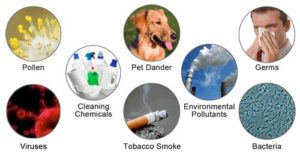The Environmental Protection Agency found that indoor air problems occupy the top 5 air quality issues faced by US households. Among these indoor pollutants include volatile organic compounds, excessive moisture, pesticides, combustion products, and radon. All these pollutants affect human health and the dampness, stuffiness, and stale air that results from them makes the entire house uncomfortable.
Control measures target both particles and gases which include smoke particles, pollen, and dust. The following are some of the pollutants and how to deal with them.
Excess Moisture
This is one of the most common, but least recognized indoor pollutants. It not only affects human health but also the integrity of the building you occupy. Among the problems brought about by excessive moisture include warm moist air encountering a cooler surface such as a window or mirror. The excess moisture condenses on the surface resulting in droplets which create an environment for mildew, mold, and dust mites.
Excessive moisture also causes high indoor humidity which facilitates off-gassing of toxins in cleaning products and furniture. This can be unhealthy and toxic.
Radon
This radioactive gas is generated from the soil and enters the house from the ground. In the United States, radon is the second leading cause of lung cancer. To control radon, you can use a simple fan that is connected to a PVC pipe system which reduces pressure coming from soil gas. In turn, these vents the radon-rich air into the atmosphere and away from your house. This system literally pulls air from under the foundation slab and exhausts it to the atmosphere at the roof level.
Volatile Organic Compounds
This includes a wide range of evaporated substances which are usually emitted by building materials, gasoline, furnishings, pesticides, or even cooking processes. A large number of volatile organic compounds are not harmful as such, but some such as formaldehyde may threaten your health.
Combustion Products
Gas-fired appliances such as water heaters, furnaces, and dryers produce carbon monoxide, carbon dioxide, and nitrous oxides. If there is no proper ventilation for the system, the air around the unit may cause backdrafting thereby sacking in combustion pollutants into the house. Of the combustion products, carbon monoxide is the most dangerous because it is an odorless, colorless, and toxic gas that is difficult to detect without a specialized detection system. The solution to minimizing the effects of combustion products is to ensure that systems are properly ventilated.
The final indoor pollutant is tobacco smoke. The effects of this are well documented and the consequences easily spill over to non-smokers. Having an indoor air quality assessment can help you document the existing pollutants and find ways of how to deal with them.


